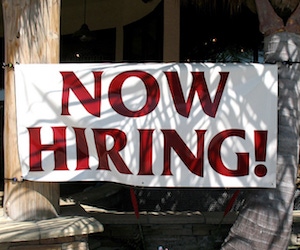What will a Trump administration mean for plastics jobs?
The number of U.S. jobs will increase, and so will salaries, as baby boomers leave the workforce and the law of supply and demand exerts its influence. That is not tied to policy or politics, but President-elect Trump’s promise to boost infrastructure spending could amplify this shift.
December 12, 2016

The recent U.S. election would seem to have implications for many parts of the political landscape, from the Supreme Court to immigration to healthcare. The election came about five months after the Brexit vote, and was followed just recently by the resounding defeat of Italy’s constitutional referendum. This feels historical somehow, but in the moment, it’s always hard to have the perspective that only time ultimately will allow. Like most Americans, I’m trying to sort this all out with a primary focus on how it affects my world—the recruitment of U.S. talent within the plastics, packaging and polymer technology space. I see three likely employment trends for our industry over the next few years, based on what we know, and what we can reasonably predict.
|
Image courtesy ***Karen/flickr. |
The number of U.S. plastics jobs will increase. The pendulum of off-shoring had already started to swing back and, at the very least, it will get a small push from the current political climate. Per the Bureau of Labor Statistics (which groups plastics and rubber together), industry employment topped out at around 950,000 in the year 2000, and began a steady decline through 2010, when it hit a low of around 615,000. Some of the net job loss was due to productivity gains, such as increased use of automation, but much was simply off-shoring to low cost countries such as China. Since then, we have seen a slight bounce-back to the current level of around 690,000. The gains, however, have lost momentum, with virtually no increase over the last two years.
More so than most industries, plastics manufacturing is poised to capitalize on any re-shoring due to innovation in materials, design and processing technology. Note that the jobs will be nowhere near a one-to-one replacement of those originally off-shored; we’re not talking about turning back the clock. Factory automation can be implemented in the United States for about the same cost as anywhere else. That will mean jobs for engineers and technicians, more so than for operators. It has been well-publicized that Apple is mulling options to re-shore iPhone production. The smart money is betting on that ultimately not happening, but it’s only a matter of time before some big names hop on the re-shoring bandwagon. Many factors have changed since those companies made their initial decision to off-shore, and the original competitive advantage may be completely gone, or small enough that some will just “do the right thing.” This could be even more significant if companies are fearful of missing out on a new Made in America movement. One other note—there will be bi-partisan support for massive infrastructure projects and the plastics industry will come along on that ride.
Salaries will increase. As reported in PlasticsToday, salaries and total compensation in the industry have stagnated for quite some time. Over the past two years we have seen a net decrease, and the average annual increase over the past decade has been in the 1% range. As demand for workers gradually begins to increase, the demographic reality is that supply will continue to decrease. The baby boomers (ages 52 to 70) have been leaving the full-time workforce at a rate of around four million per year for some time now. This supersedes politics and policy as a factor in the labor force. For the plastics industry, it means that there will continue to be a steady drain of skills and experience for the next 10 to 15 years.
With demand for workers increasing and supply decreasing, the basic law of supply and demand will begin to exert itself and we will reverse the recent trend of stagnant compensation. To this macro-level analysis, I can add anecdotally that we are rapidly becoming a candidate-driven market for highly-skilled plastics professionals. Going forward, I believe we will revert to average increases more in line with other industries, which would mean closer to 3% than 1%. That may not seem huge from the perspective of an individual paycheck, but on a macro level, it is.
Contract labor will increase. Whether you call it a part-time job, a contract assignment, a contingent job or consulting, this is another trend that will continue. It is an obvious bridge between a talent shortage on one hand, and a large group of workers who have the skill set on the other. This will include many who are semi-retired but still want to work part time. Companies can bring in people with decades of plastics industry experience with little short-term training costs. Once mostly reserved for seasonal, temporary production floor help, we are increasingly seeing contingent work with technical professionals, engineers, designers and manufacturing management. This has been ongoing for many years, although not as much in the plastics industry as we’ll see in the future. One other driver for the use of contract labor is what healthcare will look like if the Affordable Care Act, aka Obamacare, is repealed. That is another area where the new administration has vowed significant change, which in the short run means uncertainty, and businesses hate uncertainty. Contract labor will help companies to deal with that, at least in the near term.
If your livelihood is tied to having good U.S. jobs in the plastics industry, should you be singing, “Happy Days Are Here Again?” Maybe not in the office—that would just be weird—but I think there is reason for optimism. While the path forward is open to conjecture and debate—tariffs, lowering corporate tax rates, regulatory reform or Twitter rants—we do know that there will continue to be incentives offered in one form or another for creating jobs. When it comes to specific laws, regulations, and policies, we must be careful to sort out what we know from what we are perhaps hoping or lobbying for, fearing or predicting. Slapping a 35% tariff on everything coming from overseas seems hyperbolic, and I suspect that, in the end, we will deal with TPP and NAFTA quite differently, which Clare Goldsberry addressed very well in a recent article.
Paul Sturgeon is business manager for KLA Industries, the largest plastics recruiting firm in the United States. Its clients include the most innovative and fastest growing leaders in the plastics industry. To learn more about KLA, visit its website at www.klaindustries.com.
About the Author(s)
You May Also Like





